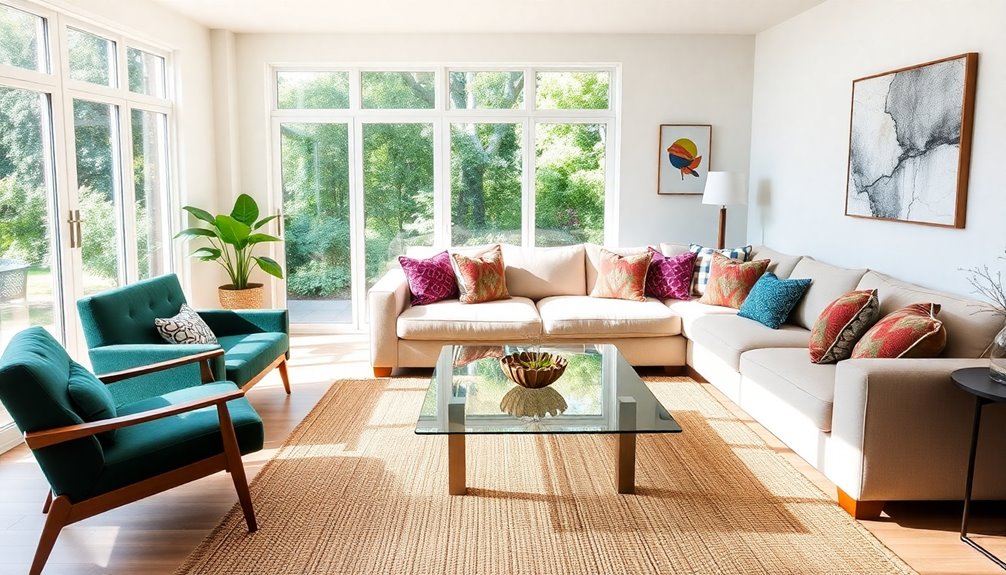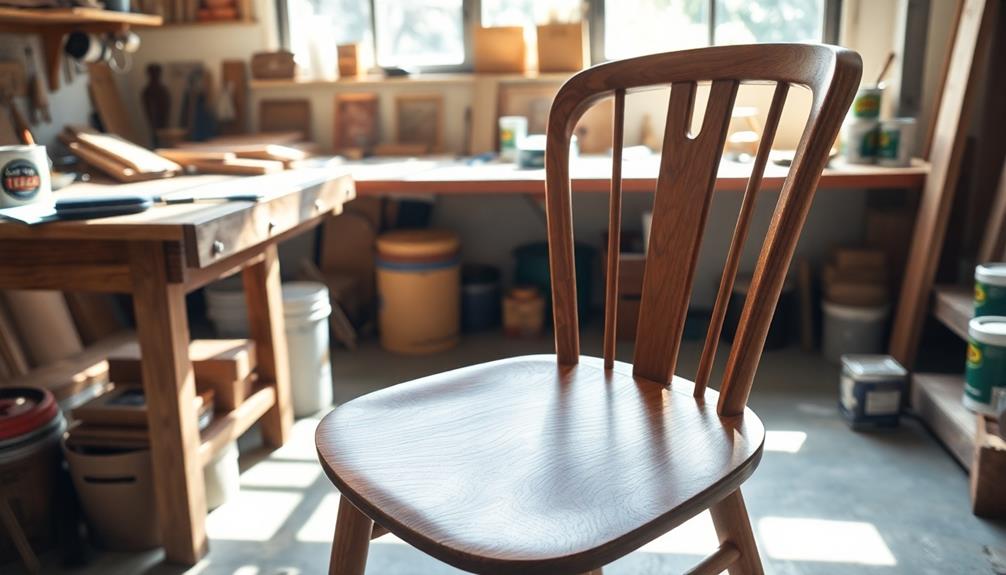To place furniture in your living room effectively, start by identifying a focal point, like a fireplace or artwork. Arrange seating to create cozy conversation areas, keeping at least 18 inches between pieces for easy movement. Balance larger furniture with lighter pieces to enhance visual harmony and use area rugs to anchor your space. Ensure pathways are clear for smooth traffic flow, and experiment with different layouts until you find the perfect fit. Add appropriate lighting for ambiance and functionality. With a few adjustments, you'll create a welcoming atmosphere that reflects your style and needs. Discover more ideas to perfect your space!
Key Takeaways
- Determine a central focal point, such as a fireplace or artwork, to guide furniture placement and decor alignment.
- Ensure at least 18 inches of space between furniture for easy movement and accessibility around doors and openings.
- Create comfortable conversation areas by positioning seating within a 7 to 10-foot circle around the focal point.
- Use area rugs to anchor furniture, ensuring they extend 6-18 inches beyond larger pieces for visual balance.
- Layer different lighting types, including ambient and task lighting, to enhance the overall atmosphere and functionality of the room.
Choose a Focal Point
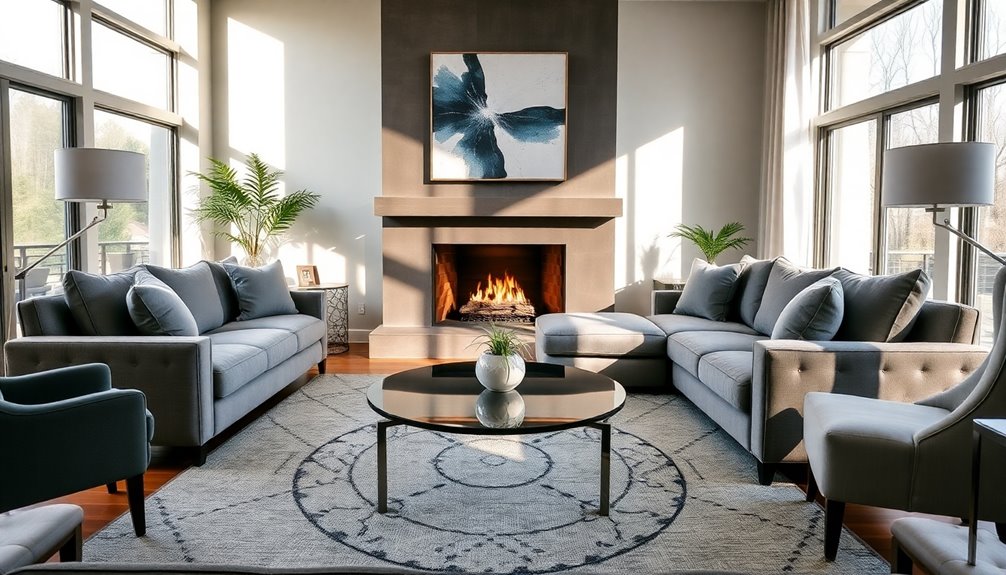
When designing your living room, start by identifying a focal point that captures attention. This could be an architectural feature like a fireplace or a stunning window with a view. If you don't have those, consider a striking piece of artwork or an accent wall with bold wallpaper. Your focal point sets the tone for the entire room, so choose wisely.
Think about existing architectural elements, too. Unique ceiling designs or built-ins can elevate your focal point. If your room has multiple focal points, like a fireplace and a beautiful view, you'll need to consider how they interact with each other. Once you've chosen your focal point, ensure that your decor and furniture align with it. The primary focal point should be emphasized through color, texture, and arrangement to draw the eye naturally to that area.
Use surrounding decor, like built-ins or lighting, to enhance its prominence. Subtle colors and textures in secondary areas help maintain a balanced look without overwhelming the space. Remember, the right focal point not only defines the living room but also creates an inviting atmosphere for you and your guests.
Determine Furniture Placement
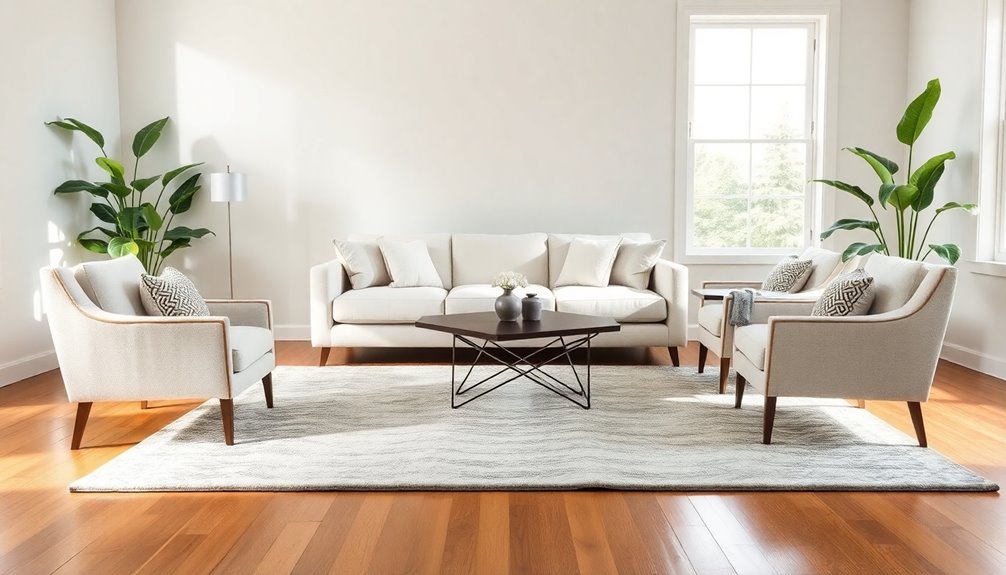
Determining furniture placement is crucial for creating a functional and inviting living room. Start by identifying paths of travel based on doors and openings. You'll want to leave at least 18 inches between sitting area furniture and other pieces to ensure easy movement. Keep walkways clear, especially around entry and exit points, to avoid obstructions. Additionally, consider using scratching posts to redirect pets if you have cats, as they can influence your layout choices.
Next, arrange tables and storage cabinets strategically. Position side tables and coffee tables within arm's reach for convenience, and ensure storage options can open fully without hitting other furniture. It's essential to keep items requiring electricity near outlets for accessibility. Regularly trimming your cat's nails can also help maintain your furniture's condition while allowing you to focus on the design.
Maintain visual balance and proportion by mixing sizes and shapes of your furniture. Avoid clustering large pieces on one side; instead, pair heavier items with lighter ones to create harmony. Incorporate a variety of textures and lines for added interest. Additionally, ensure that you leave enough space for traffic flow to enhance the usability of the room. Consider the placement of your furniture to encourage conversation and connectivity. Creating zones within a larger space can help define areas for different activities, such as lounging or reading. For more effective designs, explore furniture arrangement tips and tricks that will enhance both aesthetics and functionality, ensuring your space feels inviting and well-organized.
Finally, test and adjust the layout. Draw a layout from an aerial view to visualize your space, moving pieces around until it feels right. Consider the room's purpose and how it'll be used daily. Don't hesitate to seek help from an interior designer if you need expert guidance in spatial planning.
Create Conversation Areas
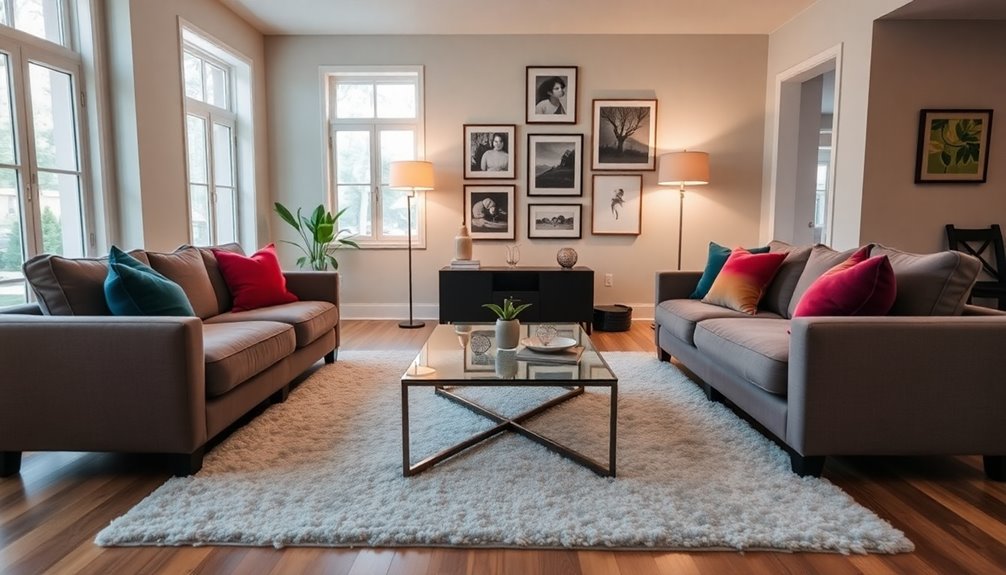
Creating conversation areas in your living room enhances social interaction and makes the space feel inviting. Start by identifying the main pathway to avoid placing your seating in the middle of it. Aim for a 7 to 10-foot wide circle for your conversation zone, ensuring all furniture fits comfortably. Group your seating around a distinct anchor, like an area rug, to visually define the space.
Arrange your furniture to enhance interaction. Position seats side-by-side and slightly facing each other, encouraging open dialogue. Keep chairs no more than 9 feet apart to maintain a cozy atmosphere. Use coffee tables and side tables within arm's reach to enhance convenience. Additionally, ensure that your seating arrangement allows for easy movement around the furniture to promote a fluid conversation environment.
Establish a focal point, such as artwork or a fireplace, that encourages conversation. Ensure all seats face this focal point and use decorative elements to enrich the area. Maintain 1 to 2 inches of spacing between furniture for comfort, and leave about 18 inches between the coffee table and seating for easy navigation. Lastly, give your furniture breathing room by avoiding walls, which keeps the layout feeling balanced and connected.
Ensure Balance and Proportion
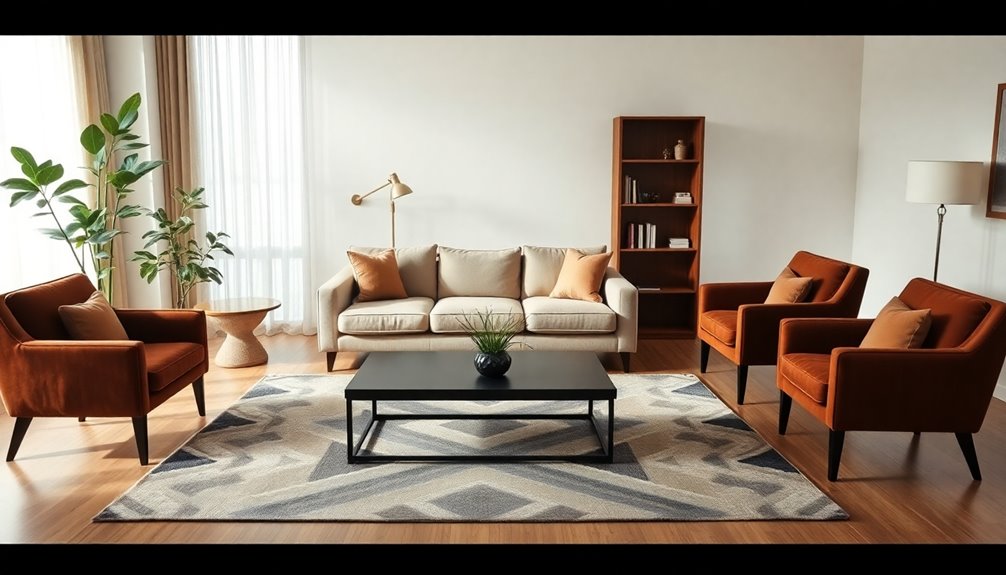
Achieving balance and proportion in your living room is essential for a harmonious design. Start by matching your furniture to the room size. Larger spaces can handle bigger pieces, while smaller rooms need scaled-down furniture to maintain visual harmony. Also, consider ceiling heights—tall furniture works well in rooms with high ceilings, while shorter pieces suit low ceilings. In narrow rooms, be cautious with furniture depth; deeper sofas can make the space feel cramped.
Mix items of different scales to add interest, but avoid drastic differences that can create chaos. For example, pair a large piece of art with a substantial fireplace to maintain proportion. Your coffee table should be about two-thirds the length of your sofa for optimal balance. Understanding proportion in furniture is vital for creating a comfortable and visually appealing living space.
In terms of shape, round tables can soften the lines of a square room, while rectangular ones can elongate a narrow space. Balance heavier pieces with lighter ones and ensure a mix of heights among your furniture. Avoid clustering large items on one side, and use focal points like fireplaces or windows to anchor the layout. Experiment with different arrangements until you find the perfect balance for your living room.
Consider Traffic Flow
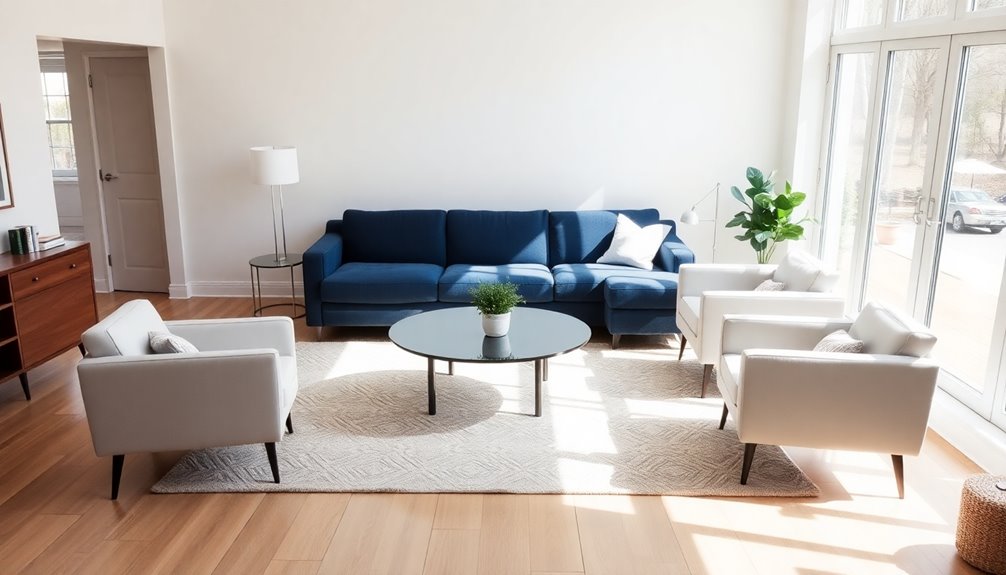
When arranging furniture in your living room, considering traffic flow is crucial for a functional layout. Start by identifying natural circulation routes on your floor plan. Mark the center of doors, entrances, and pathways, connecting them to visualize where people will walk. Pay attention to the shortest routes between rooms, ensuring they're clear of obstacles.
Keep traffic paths obstacle-free by avoiding large furniture pieces that can block pathways. Leave at least 18 inches of space between sitting area furniture and other obstacles, and make sure doors can open freely without hindrance. Aim for short and direct routes to reduce frustration and potential hazards, hugging the edges of the room whenever possible.
Also, consider the function of your room. Position your largest pieces, like sofas or chairs, facing a focal point, such as a fireplace or window, to create a natural flow. Proper traffic flow is essential to balance the visual weight around this focal point while ensuring that major traffic paths don't cut through conversation or viewing areas. By thoughtfully planning traffic flow, you'll create a living space that's both inviting and functional.
Plan and Test the Layout
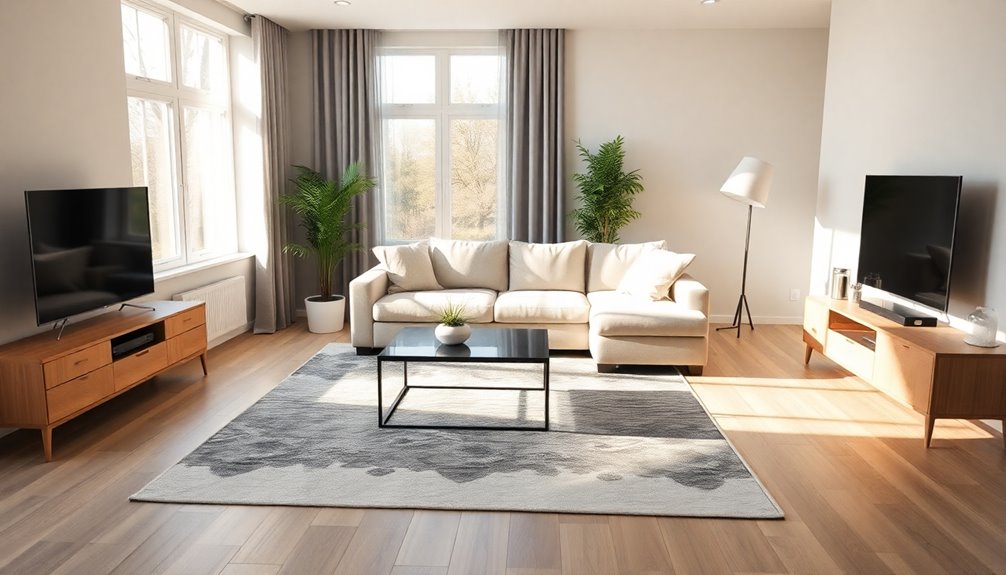
After establishing a clear traffic flow, it's time to plan and test the layout of your living room. Start by measuring the room and noting architectural features like windows and doors. Create a floor plan using graph paper or online tools to help visualize the space. Don't forget to measure your existing furniture and cut out paper representations to move around on your plan.
Next, choose a focal point—whether it's a fireplace, a large window, or a piece of art. Arrange your furniture to draw the eye toward this feature, ensuring it's central and accessible. Balance the visual weight around the focal point to create harmony in the room. Incorporating mood boards can also help visualize how the furniture arrangement aligns with your overall design concept.
Now, test different layouts. Use blue tape on the floor to mark potential furniture arrangements, or try interior design apps to visualize options before purchasing anything. Pay attention to how each configuration affects flow and functionality. Consider using a flexible layout to allow for easy reconfiguration as your needs change.
Finally, refine your layout, ensuring it allows for easy movement and doesn't obstruct pathways. Adjust for balance and scale, adding accent furniture as needed. Make final tweaks based on your preferences to achieve a cohesive, inviting space.
Use Area Rugs Effectively
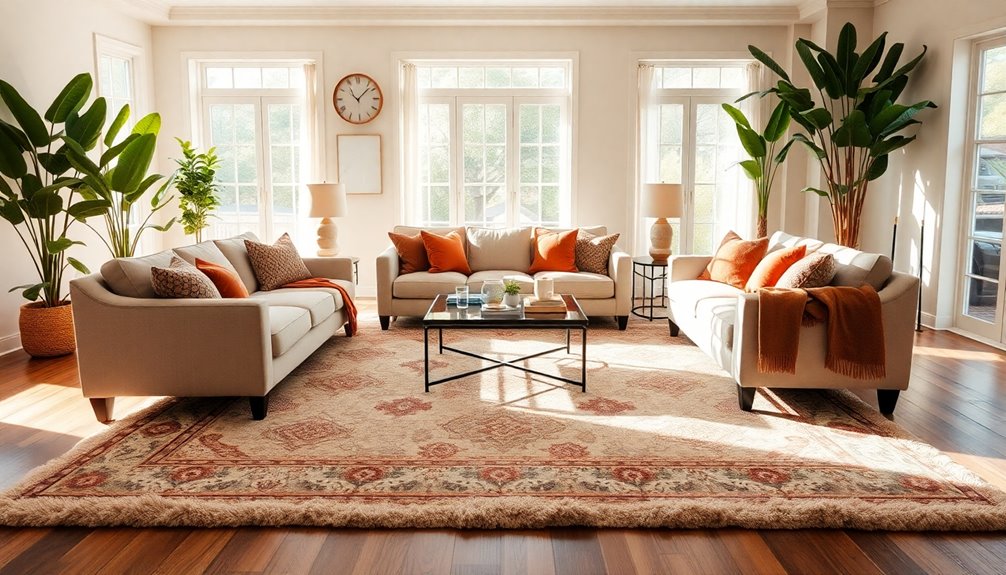
Area rugs play a crucial role in defining your living room's space and style. To effectively position your furniture, aim to place the front legs of larger pieces, like sofas and armchairs, on the rug. This anchors the furniture and clearly defines the area. For a unified look, consider placing all legs on the rug, especially in open-plan spaces.
Select a rug that extends at least 6-18 inches beyond the furniture edges to maintain balance. Centering the rug in the room creates a focal point, aligning it with the coffee table for an equal flow of space around it. Ensure there's an equal amount of bare floor around the rug's edges to enhance harmony. Utilizing the appropriate rug size not only ensures comfort but also complements your furniture arrangement.
When choosing the right size, small rugs work well for accent areas, while larger rugs should encompass your main furniture grouping. Allow 8 to 24 inches of clearance around the edges to avoid blocking pathways. Finally, use the rug as a visual anchor, combining it with various textures to create aesthetic harmony. This approach not only defines your seating area but also adds warmth and cohesion to your living space.
Incorporate Lighting Solutions
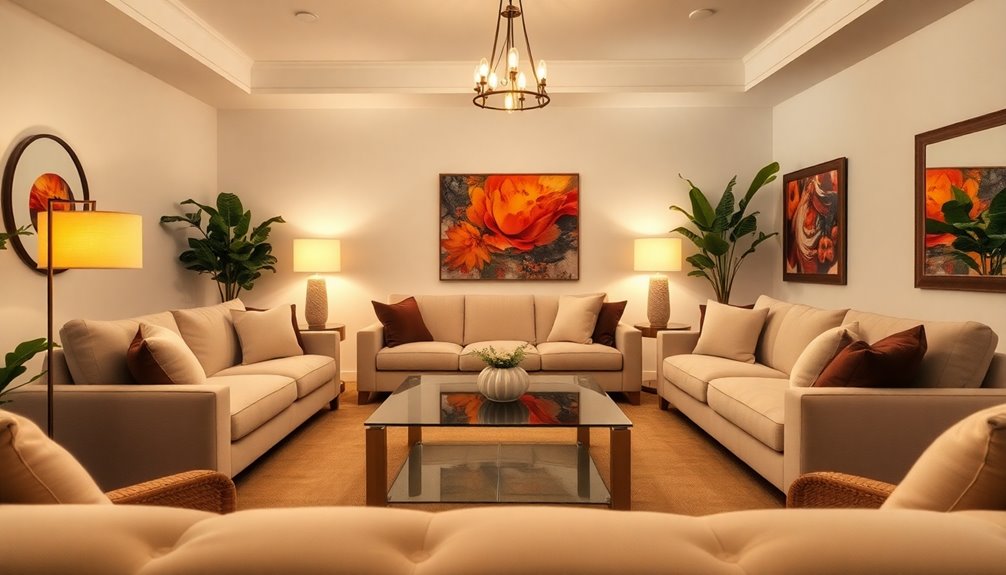
To create a warm and inviting living room, lighting solutions should complement your furniture arrangement and overall design. Start by understanding the types of lighting available: ambient, task, accent, and decorative. Ambient lighting, like chandeliers or flush mounts, provides general illumination, while task lighting from table or floor lamps focuses on specific areas, such as reading nooks. Accent lighting can highlight artwork or plants, adding depth to your decor. Additionally, consider incorporating smart lighting technologies that allow for customizable settings and energy efficiency.
When placing lighting fixtures, install ceiling lights centrally above seating areas for balanced ambient light. Position floor lamps near seating for both task lighting and decorative flair. Table lamps on side tables enhance decor and provide focused light. Wall sconces can illuminate artwork or architectural features, adding warmth. Additionally, consider using energy-efficient lighting options, such as LED bulbs, to reduce electricity consumption while enhancing your space.
Consider integrating your lighting with furniture layout by using focal point lighting to highlight elements like a fireplace. Create distinct zones with lighting for reading or workspace areas. Ensure a balanced illumination throughout the room; avoid clustering light sources on one side. Lastly, choose lighting that matches your design style, whether it's modern or traditional, for a cohesive look.
Personalize Your Space
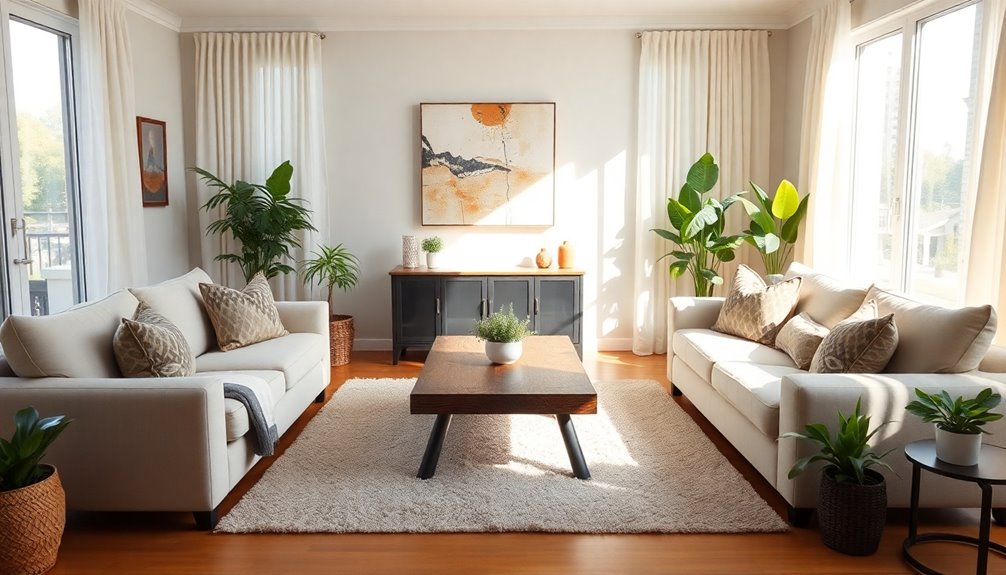
Personalizing your space transforms a generic living room into a reflection of your unique style and lifestyle. Start by understanding the room's purpose. Decide if it'll be a cozy retreat for relaxing, a vibrant area for entertaining, or a multifunctional space. This will help you determine how to zone the room effectively, incorporating areas for lounging and dining as needed.
Next, create a focal point. Highlight architectural features like large windows or a fireplace, or introduce art pieces that draw the eye. Arrange your furniture to enhance this focal point, making it a natural gathering area that anchors the space.
Ensure easy movement and flow throughout the room. Identify pathways based on doors and openings, keeping them clear. Aim for at least 18 inches between seating areas and maintain 36 inches around dining tables for comfort, ensuring that you have unobstructed pathways for comfortable movement throughout the room.
Finally, focus on balance and proportion. Avoid clustering large pieces on one side; instead, mix heavier furniture with lighter options. Use area rugs to define spaces and test different arrangements until you achieve a harmonious balance that suits your lifestyle and enhances your living room's functionality.
Frequently Asked Questions
How Do I Choose a Color Scheme for My Living Room?
Choosing a color scheme for your living room starts with identifying the mood you want to create. Look at saved images for inspiration and decide on a cool, warm, neutral, or bold palette. Use the 60-30-10 rule for balance, ensuring your colors complement each other. Consider existing elements like rugs or furniture, and test colors in different lighting. Create a cohesive design by repeating colors throughout the room for harmony and interest.
What Type of Materials Should I Use for Furniture?
When choosing materials for your furniture, consider your lifestyle and aesthetic preferences. If you want comfort, go for fabric like cotton or linen. For durability, leather's a great choice, especially with kids or pets around. If you prefer a natural look, opt for eco-friendly materials like bamboo or wool. For a modern vibe, metal and glass can add sophistication to your space. Pick what fits your needs and enhances your overall design!
How Can I Incorporate Plants Into My Living Room Design?
To incorporate plants into your living room design, choose varieties that match your light conditions and mix different sizes for depth. Use decorative planters that complement your decor style, and group plants in odd numbers for a natural look. Position them strategically on shelves, tables, or in corners to enhance the space without obstructing views. Adding trailing plants can draw the eye upward, creating a vibrant and inviting atmosphere in your living room.
What Size Area Rug Is Best for My Living Room?
To find the best area rug size for your living room, measure your space first. For smaller rooms, a 6'x9' rug works well, while mid-sized areas typically use an 8'x10' rug. Larger rooms can accommodate a 9'x12' or even a 10'x14' rug. Make sure the rug extends 6" to 8" beyond your furniture and anchors your seating area, creating a cozy and inviting atmosphere without overcrowding the room.
How Can I Create a Cozy Atmosphere in My Living Room?
To create a cozy atmosphere in your living room, start by layering soft textiles like plush throw blankets and cushions. Use warm lighting with dimmable fixtures and strategically placed lamps for a soothing glow. Incorporate natural elements, such as indoor plants and wooden decor, to bring warmth. Don't forget personal touches like framed photos or artwork that reflect your style. These elements will invite comfort and make your space feel welcoming.
Conclusion
By following these tips, you can transform your living room into a welcoming and functional space. Remember to choose a focal point, create conversation areas, and ensure a good flow for movement. Don't forget to balance the furniture and personalize your decor to reflect your style. With a bit of planning and creativity, you'll have a cozy living room that's perfect for relaxation and entertaining. Get started today and enjoy your new, inviting space!
